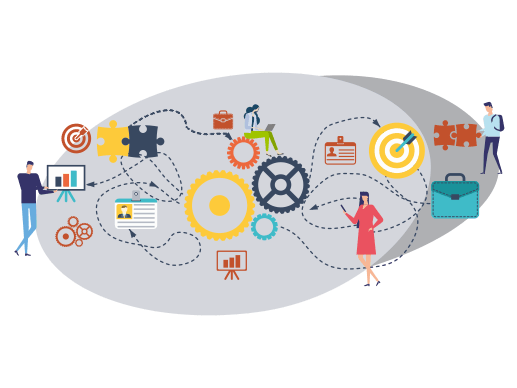

Transform your Products with
Enterprise Integration
for real-time response

Digital transformation impacts customer experiences, operational processes and business models, all of which in today’s connected world, require real-time response from businesses. Integrated business workflows for manufacturing, purchase, sales, marketing, billing, customer support, field service and other functions are becoming a key digital transformation element to share information quickly and on demand to remain competitive. Applications and devices need to be accessible to each other. Big data needs to be collected, shared and acted upon in a timely manner.
If yours is a product or services business, you will need to consider varying levels of integration between your product and services offerings and your business systems to achieve your digital transformation goals. Depending on your target customers, you may also have to offer integration functionality in your products and services to enable your customers to achieve integration within their businesses.
Traditional methods of integration using point-to-point connections are failing due to several complexities and challenges:
Modern enterprise integration enables you to overcome these challenges and achieve digital transformation by connecting applications, devices, and data for a real-time response. With a suite of software spanning mobile, Web services, SaaS applications, databases and cloud solutions, modern enterprise integration solutions unifies systems, services and applications seamlessly, and ensures continuous, effective and flawless performance. Integration becomes less complex and upgrades are easy and quick because all integration assets are kept in a universally consumable manner, all connections are available in a cohesive layout or IDE (integrated development environment) and reusable, documented, universal APIs overcome the disorganization of point-to-point connections. Appropriately designed and published APIs for your products and services also address the enterprise integration needs of your customers.
Enterprise integration of various systems involves detailed business process mapping and a deep understanding of how applications work together, in terms of integration points, protocols involved, security requirements, user and application authentication, and transaction logging.
Do you have an effective integration strategy for your products and services?
Connect with us today to transform your offerings with enterprise integration.
Digital transformation is driving changes in enterprise integration. Some of the trends in enterprise integration include:


Cloud-based integrated solutions, running multiple applications, are gaining precedence in enterprise integration over on-premise models due to competitive pricing, easy maintenance, and faster connectivity.

Enterprise Application Integration (EAI) solutions with a middleware framework are enabling open and secure sharing of data between heterogeneous applications, such as ERP systems, CRM applications, BI Applications, and legacy systems that are incompatible with each another.

Real-time application integration for interaction between applications and systems is being enabled by the availability of APIs in mobile apps, wearable devices, IoT devices etc. This is resulting in real-time data flow and synchronization between apps and devices.

SMBs are increasingly adopting service-oriented architecture (SOA) based integration, which is prevalent in large enterprises, instead of point to point integration, which is a common practice in SMBs and results in spaghetti code that does not scale and is difficult to maintain.

Integration of on-premise and cloud systems using secure transport is increasingly becoming popular. Though enterprises may desire to migrate to the cloud entirely, there are good reasons to adopt a hybrid approach, where part of the application still runs on-premise. This could be due to privacy and security concerns, ability to work offline and latency considerations.

Large enterprise are no longer relying on SaaS type of integration for handling growing complexity. They run their business logic using PaaS and IaaS also. iPaas, a cloud integration solution, enables such complex integrations. It offers developer tools to build simple custom integration with these cloud services.

Data Platform as a Service (dPaas) is helping enterprise integration with data centric integration and data management by focusing on the data from enterprise applications. EAI is helping accelerate this trend by incorporating data integration.
Are you facing challenges in implementing enterprise integration for your products and services?
Connect with us today to leverage our enterprise integration expertise.
At Celstream, with nearly two decades of experience in delivering product engineering services for diverse and complex products and apps, we understand what it takes to implement enterprise integration of your applications, data and devices as part of your digital transformation strategy.
Our product engineering services teams are experienced in integrating heterogeneous systems like edge devices, on-premises solutions, mobile apps, cloud applications and third party enterprise systems.

Celstream uses the following approach for designing and implementing enterprise integration scenarios:
The new paradigm of development of mobile and Web applications leverages HTTP and AJAX, and using REST Services to deliver dynamic data content consisting of JSON packets to Web browsers and thin clients. Mobile apps are seamlessly integrated using cloud messaging services for delivering almost instantaneous notifications.
The challenges of back-end integration to meet the changing requirements are expertly handled using industry standard integration platforms, including AWS®, Microsoft Azure®.and MuleSoft, This approach minimizes the changes required for the overall solution. Also, this enables exposing the business workflows to entirely new set of devices and third party applications in a quick and flexible manner.
We have extensive experience in using and building connectors for several SaaS platforms like cloud storage systems, social media platforms, medical workflow systems, document management systems, email systems, content management systems, digital marketing platforms, multiple database systems, and several enterprise resource management systems.
Our back-end integration expertise includes:
TRANSFORM YOUR
PRODUCTS AND SERVICES TODAY!